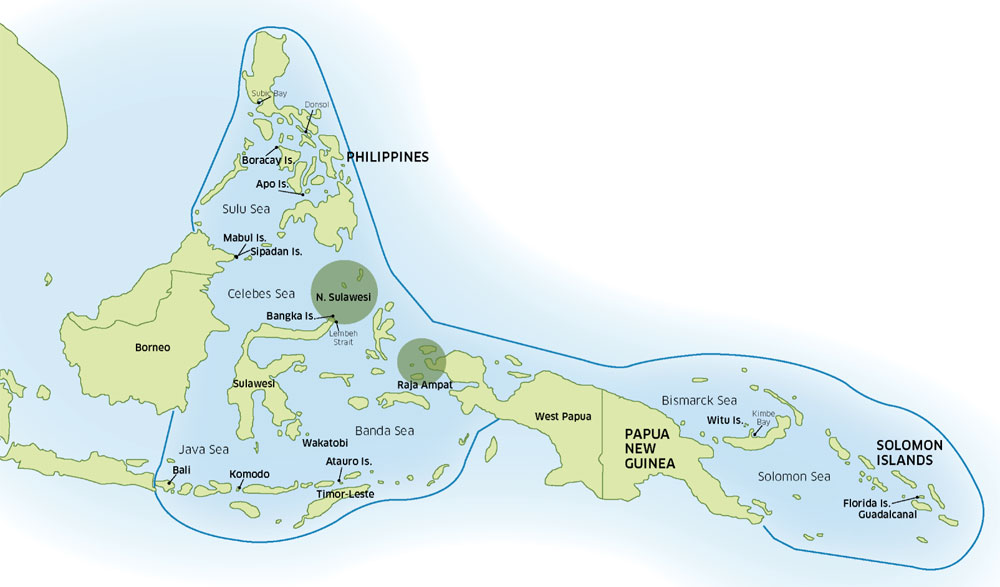
We are philanthropic organisation of eco-entrepreneurs, scientists, divers and environmentalists committed to coral reef ecosystem conservation. Based in the Philippines, we are responding to the challenge of protecting one of the most diverse marine habitats on Earth by developing a scalable, sustainable solution for the Coral Triangle’s fishing communities.
We are on NETFLIX Europe. Click to view the 7- minute trailer.

The Coral Triangle is a marine area located in the western Pacific Ocean. It includes the waters of Indonesia, Malaysia, the Philippines, Papua New Guinea, Timor Leste and Solomon Islands. Named for its staggering number of corals (nearly 600 different species of reef-building corals alone), the region nurtures six of the world’s seven marine turtle species and more than 2000 species of reef fish. There are over 2,000 languages spoken across these waters and cultures share a strong connection to the sea.
Overfishing, destructive fishing methods and nonselective fishing gear used by visiting fishermen have harmed the Coral Triangle’s fragile reefs and devastated the fish and other marine animal populations in the ocean.
Coral Triangle marine resources support the livelihoods of over 120 million people and provide food to local coastal communities and millions more worldwide. The region also holds incredible cultural diversity.
Current levels and methods of harvesting fish and other resources are not sustainable and place this important marine area and its people in jeopardy. A changing climate threatens coastal communities and imperils fragile reefs.
We work directly with fishing communities to create Locally Managed Marine Areas (LMMA’s) in the Coral Triangle. LMMA’s protect coral reefs and sea grass beds from destructive fishing practices and other unsustainable activities.They also allow damaged areas to recover, which is important for resilience against climate change. Protected areas allow fish to reproduce and grow to their adult size. This enables depleted fish populations to recover and increases fish catches in surrounding fishing waters. They provide refuge for other marine species too, such as endangered marine turtles and dugongs.
The acronym ‘NEOLI’ is a term used by ocean-activists to describe the key features of marine protected areas that result in successful design and management. We have used NEOLI used to guide our decision to identify an area in the Coral Triangle for the BANUA our first pilot-project.
Learn more about NEOLI >
NEOLI Factors
No-take, LMMA’s are more successful when they are fully protected, so that there is no fishing at all, compared to some LMMAs where some fishing is allowed, or some species can be fished but not others;
Enforcement, LMMA’s are more successful if people don’t cheat, or fish illegally in the LMMA;
Old, LMMA’s are more successful if they are old, where old means 10 years or more;
Large, LMMA’s work better if they are large, where large means at least 100 km2;
Isolated, LMMA’s work best when they cover the entire area to be protected, such as a deep channel or isolated island where reef fish cannot forage outside the LMMA.

Protect and regenerate reefs, sequester blue carbon and engage fishing communities in reef conservation and restoration activities.
Fishing communities about the importance of coral reef ecosystems and how to better manage marine protected areas.
Reduce a community’s reliance on fishing by incubating locally owned and managed businesses creating jobs and providing a steady source of income for the community.
The Conservancy is building BANUA, a marine monitoring station on an island in Palawan, Philippines, in partnership with the Tagbanua, a tribal community that live on the island. We identified the ocean around the island as an area of high biodiversity that met the NEOLI success factors for an LMMA.
We wrote a plan for fisheries management resulting in the decision by the Tagbanua to establish an LMMA and partner with us to develop a proof-of-concept incubator that offers a sustainable solution for their community and can be scaled up and applied across the Coral triangle.
See our progress so far >
BANUA our progress so far
RESTORE: We built an active coral reef restoration site in the ocean in front of BANUA and trained a marine protection team to patrol the site.
EDUCATE: Children are our future which is why we established an Island School to provide a combination of primary school education and practical marine science experiential learning.
INCUBATE: We designed and built the BANUA marine monitoring station. BANUA currently comprises: our 200 sqm HQ, a typhoon-proof building housing administrative offices, a science laboratory and spaces for training and equipment storage. Volunteer accommodation is provided by two native-style 50 sqm villas for up to 6 visitors featuring a studio bedroom, outdoor shower and instagram-perfect views of the ocean. We own three small gas-fueled banca trimarans for field research and restoration.
During construction Banua employed 12 staff and post construction the camp employs 5 staff.
80% of the infrastructure remains in place but we must restore roofs, rehire local staff and cover costs for reef protection and daily expenses.
Complete Banua’s existing infrastructure. Upgrade the two existing nativestyle, 50 sqm volunteer accommodation for 6 visitors; purchase a 50ft Banca trimaran; install a solar-electric engine to transport visitors to and from the island. Build staff accommodation. Salaries for 8 local and 3 international hires.
Build six more 50 sqm nativestyle, volunteer accommodation for 20 visitors. Add scuba diving facilities. Salaries for 24 local and 5 international hires.
Add six marine protected areas to our network with a total capacity of 80 visitors. Each area will have a similar infrastructure to the BANUA but offer visitors a different experience from mangroves to bird spotting. Visitors can go LMMA- hopping and stay at each new area. Fund new initiatives: fisheries app, educational app, aquaponics; more solar-electric boats. Salaries for 100 local staff.
Constrained by the COVID-19 pandemic, work on BANUA was suspended in 2020 due to lack of funding because we depended on paid volunteers.
The conservancy urgently needs funding and support
to reactivate and complete BANUA and expand our
network of LMMA’s.